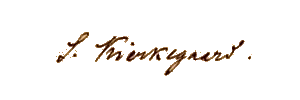|
|
|
Niels Christian Kierkegaard's drawings from 1838/1840
Peter Klæstrup's drawing from 1845(?)
Marstrand's drawings from 1870
H.P. Hansen's drawing from 1854
Niels Christian Kierkegaard’s drawings from 1838/1840
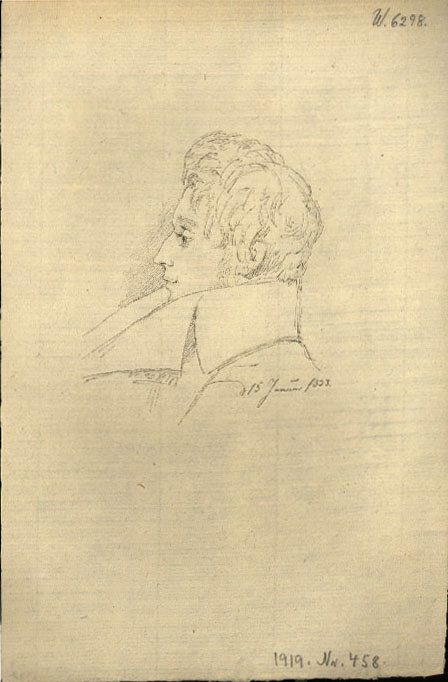
"Stukket af Knud Hendriksen". W.6298, Acc. 1919-458. Neg. 30217.
Niels Christian Kierkegaard (1806-82)
In contrast to many of his contemporaries, Kierkegaard never had a photograph
taken of himself, or a daguerreotype, as it was then called. The citizens of Copenhagen were presented with this technique as early as 1842 by the Viennese portrait painter Joseph Weninger, who set up an atelier in Bredgade, where it was possible to be immortalized in fifteen seconds for eight rixdalers. Evidently this was fifteen seconds too many for Kierkegaard. How unfortunate, though most consistent for an author who wrote pseudononymously, and persistently repeated that what the reader should be concerned with was the work and not the person behind it.
Nevertheless, Søren’s second cousin, Niels Christian Kierkegaard, managed to find opportunities to draw his later so famous relative at intervals within of a couple of years. On the drawing in profile from January 1838, the line is exceedingly delicate, there is something dreamlike, but also aristocratic over the spiritual youth who has assumed this posture. The full face drawing, done around 1840, shows the narrow form of the face, which sharpens downward from the rather broad cheek bones also known from Kierkegaard’s father and his sister Petrea. The eyes are beautiful, eternally staring, while the lines of the lips are animated.
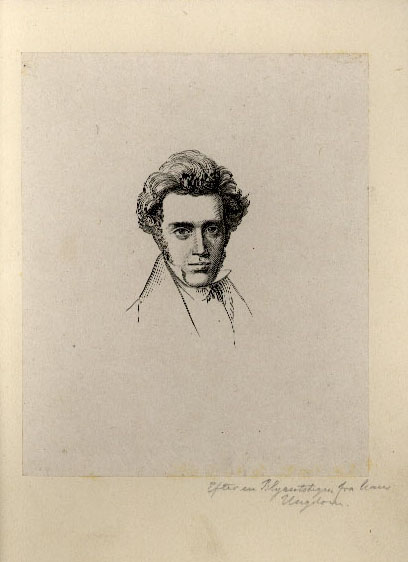
Stik. "Efter en Blyantstegning fra hans Ungdom". W.6300, Acc. 27.X.1907. Neg. 197741.
That both drawings represent an idealization is supported not only
by Søren Kierkegaard’s niece, Henriette Lund, but also
by the source of the drawings himself. In a letter of January 30,
1875 to P.C. Kierkegaard, Søren’s brother and the Bishop
of Aalborg, he writes: “You know that I drew a little quick
sketch of your brother’s profile in 1838 and several years
later started another in full face, but both of these sketches are
very incomplete and can only weakly refresh the memory of Søren
for anyone who knew him personally; and far from provide an exact
and full picture for those who have never seen him.”
Niels Christian’s reason for writing was that he had been
approached repeatedly with requests to borrow his drawings
for “copying and publication for the public,” which he,
however, has hitherto resisted. In part because the drawings were
incomplete, in part because he knew that “Søren did not
wish to leave a picture of himself, and therefore played the trick
on me of not showing up - after he had sat for me two times.”
Since there were now plans of raising a monument for the peculiar
loner, Niels Christian, however, no longer thinks that he can defend
keeping back his drawings, so much more so because the alternative
is that the “portrayals from the Corsair” be used. The
episcopal older brother answers reluctantly and excuses himself
regarding his “back and forth considerations,” in principle
he is against, but in practice he has to admit that in the long run
it will be difficult to keep refusing. True enough.
Peter Klæstrup’s drawing from 1845 (?)
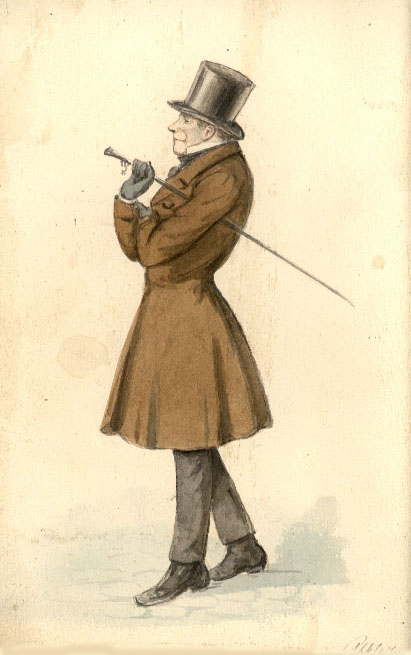
Tegning af Klæstrup. Acc. 1911-8497. Neg. 285, 169995.
It is in no way easy to be a caricature. If the resemblance is too good,
it becomes a portrait, if the resemblance is too poor, it cannot be determined who
it is that is being caricatured.
In the case of Kierkegaard the task is nearly impossible, one of his contemporaries,
the theologian P.C. Zahle, actually directly makes the claim: “Kierkegaard was
close to resembling a caricature.” When looking at Peter Klæstrup’s drawing,
which in the original is coloured most meticulously, the question
arises whether the artist is making a caricature or merely portraying
a caricature.
It is not known when Klæstrup drew this dandified Kierkegaard with the
self-confident attitude, but when he re-appeared in “The Corsair”
on Januar 9, 1846, the dandy had been replaced by shabbiness and
the self-confidence by the ludicrous. The shoulders had also been pulled
further up under the hat, the back provided with extra curvature, and as a last effect, Klæstrup had made the one trouser leg slightly shorter than the other. This last quickly turned out to be a stroke of genius. The genius had been literally caught on the wrong foot. In no time Kierkegaard, who had formerly been a natural part of the life of the city, became the city’s walking caricature,
and everyone enjoyed it as best they could. Aside from one individual.
Marstrand’s drawings from 1870
Wilhelm Marstrand (1810-73).
“The same evening that the news of Kierkegaard’s
death spread through Copenhagen, out at the poet Johannes Fibiger’s, where he chanced
to be, Marstrand made a number of loosely sketched ink drawings of Kierkegaard,
from memory - one of his specialities!” Thus wrote P.A. Rosenberg,
but his description is not completely true. Marstrand’s drawings of Kierkegaard
were not done in 1855, but all of fifteen years later. On the other hand,
it is true that one of Marstrand’s “specialities” was his memory
of visual impressions, which made it possible for him to preserve the
characteristic features of persons with eminent assurance. From the remaining
sketches from memory it is, though, clear that he had laboriously to draw himself
up to (or perhaps more correctly back to) the person from whom his many long foreign
travels had kept him at a distance.
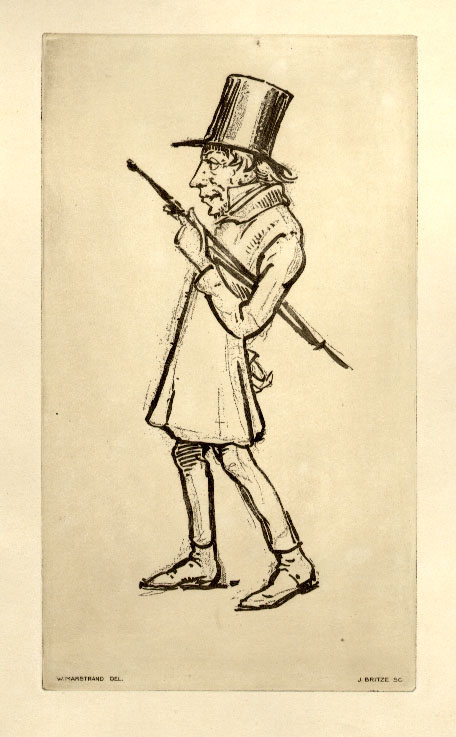
Stik. W. 6305, Acc. 1924-305. Neg. 150809.
On the sketches the profiles are without the exaggerations of caricature, but
with much divergence among them; the high forehead under the brushed up hair,
the thick eyelids and the rather wide mouth with the slightly upturned corners do,
however, reappear, as well as the large nose, the bridge of which, Marstrand - after
some consideration - choses to leave completely straight. Now he remembered Kierkegaard
sitting in a room or in a café, now he reproduced him as a street character with
umbrella and wearing a nasty tight-waisted coat, out of one pocket of which dangles a
long hankerchief, now he depicted him - as seen here - bare-headed and standing up, but
without the diagonal effect of the umbrella, by which the figure is filled with calm
and achieves the effect of an observer.
Finally Marstrand made the choice of caricature and emphasized the all too
large head and the correspondingly weak body as that peculiar to Kierkegaard.
The umbrella is on the same occasion re-introduced as a diagonal line, the
extremes of which are carefully fixed in relation to the edges of the paper;
it functions almost as a lever that can move rythmically up and down with its
mid-point exactly at the heart. This was well-chosen, it must be said, because
Kierkegaard had an exceedingly personal relationship to his umbrella. On a loose
scrap of paper from 1840 he could - under the heading “My umbrella,
my friendship” - thus make known: “It has become so dear to me, that
I always take it with me whether or not it rains or shines; yes, to show it that
I do not love it merely for its usefulness, I sometimes walk up and down the floor
in my rooms and pretend that I am out, support myself on it, put it up, support my
chin with its handle, bring it up near my lips, etc.”
H.P. Hansen' drawing from 1854
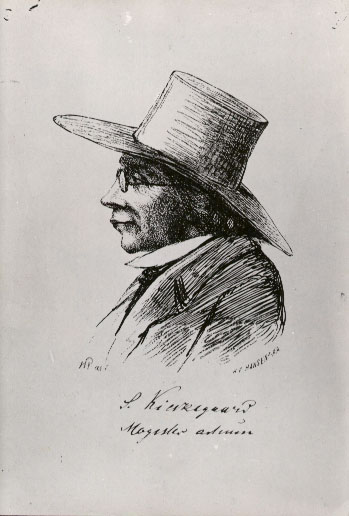
Stik. W ?, Acc.-- Neg. 2123.
H.P. Hansen (1829-99).“There lives, wrote Kierkegaard in 1854, “
no one so clever that he would be able to invent a form of cleverness that
my police eye would not immediately see, and that my cleverness can not
make obvious as a prank.” This sounds impressive, but is not completely
right. H.P. Hansen’s drawing is in two ways a “prank”
that escaped Kierkegaard’s “police eye.” In his flat
H.P. Hansen sat ready with pencil and paper when Kierkegaard marched
past and thus fixed the unaware “police spy” for later ages.
Most of the hatbrim and its upper side are visible, so H.P. Hansen probably
caught the figure from a window on the ground floor or the first storey.
It is clear that Kierkegaard wore off his delicate aesthetic look as the years
past, aging as early as he did, but the little smile at the corners of the mouth,
just as sad as satirical, is still there.
Frithiof Brandt writes, of this mouth and the man to whom it belonged: “On
H.P.Hansen’s picture the mouth has subsided into peace, become mild and sensitive,
almost muzzle-like in its resignation, that of a flute player in the orchestra, one might
think.” In that case one must think something else. The Kierkegaard seen here caused,
in that very same year, an earsplitting thunderclap when he stormed against the Danish Church.
|
